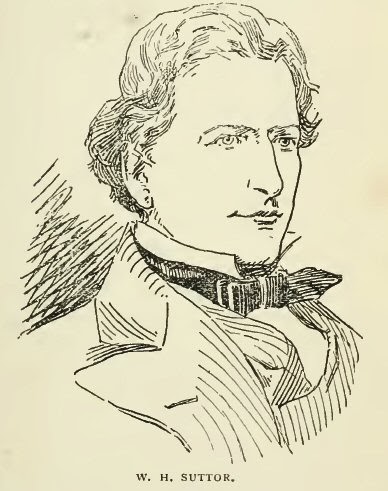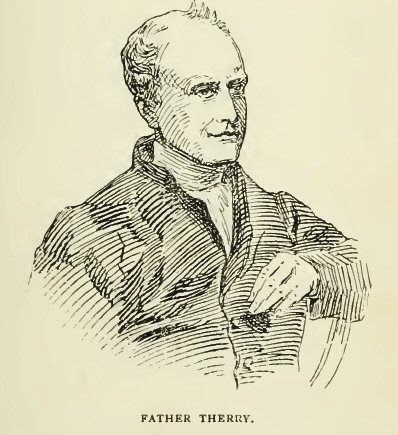In September of that year eight malcontents on the farms of Evernden and Liscombe deserted in a body, and having armed themselves with stolen guns, pistols and ammunition, traversed the district in all directions, compelling the convicts to join them, and seizing for the use of these conscripts all the arms they could reach.
Their first visit was to the farm of Mr. Evernden (then Police Magistrate of Bathurst), near Wimbledon. Here they intended to "pay out" the owner for having ordered the leader of the gang a flogging some months before for a very trivial offence. Fortunately for Evernden, however, he was away from home at the time; but his convict overseer confronted the gang and foolishly dared them to shoot him. "Join us," said one of them, "or we'll do it", and at once shot him through the breast, leaving him dying on the floor of the hut.
By intimidation and persuasion quite a large force was collected—one unofficial statement gives the number as eighty, but I cannot find any verification of this. All were more or less armed. It is said that some of the young native-born white residents had at first agreed to join them, hoping to turn the tables upon the authorities, whose hard and rigorous rule had made convict life almost unbearable; but these freeborn youngsters grew timid in the end, and refused to join the "rising."
Disaffection and fear also soon broke up their ranks, and the laggards were allowed to return to their employment and their homes, until thirteen only were left in the band; but these were all well armed, and most of them men of desperate character.
When reliable intelligence of this bushranging organization reached Bathurst a meeting of the inhabitants was convened by the magistrates and held on 27th September in the Court House. It was resolved to form immediately a corps of volunteer cavalry, for the protection of the inhabitants of the town; twelve gentlemen at once enrolled themselves, the late Mr. W. H. Suttor being appointed commander, on the recommendation of the commandant of the district, Major Macpherson.
The volunteers lost no time, and at five o'clock the same evening were ready to march. Just at that hour intelligence was brought into the settlement that the bushrangers had made their appearance at Campbell's River, and had robbed Mr. Arkell's station. The little force set out, and, pushing on at a smart pace, reached the station just before daylight next morning. By this time the bushrangers were gone, and the volunteers, hastily partaking of refreshments, pushed on after them. Mr. Suttor here met with two friendly aborigines, who were persuaded to act as guides, and tracked the fugitives to a rocky glen on the Abercrombie River.
It was nearly sunset when the volunteers came in sight of the camp. They dismounted under cover of the trees, and prepared for instant action. A small detachment was sent round by Mr. Suttor to make an attack in the rear, while the main force charged in front; but one of the men sent round dislodged a stone when climbing a steep bank, and so roused the bushrangers, who at once sought cover and began a determined fire upon their assailants. Although they did not anticipate so warm a reception, the volunteers returned the fire with spirit, and for fully an hour the firing was kept up on both sides. Mr. Suttor, being the leader, had several narrow escapes, as the bushrangers sought to put him out of the way first.
Two of the bushrangers were wounded in this encounter, but scrambled into a safe position, and were not then secured. The settlers, having expended nearly all their ammunition, as a last resort made a feigned charge to secure greater safety in the retreat which they saw was necessary. The ruse succeeded: a number of the bushrangers ran from their positions and the volunteers were enabled to retire with comparative safety, although the leader of the banditti rallied his men and followed the retreating party for some distance. He named those whom he wished to have shot, telling his followers not to be flurried, but to pick their men; but in calling out the names he revealed the fact that he was mistaken as to the assailants, being under the erroneous impression that Mr. Evernden was in command. The attacking party soon regained their horses, which had been left in charge of the two blacks and a boy taken from the bushrangers, and Mr. Suttor despatched a letter to Major Macpherson, giving an account of the affair. The result was that a reinforcement of soldiers stationed at Bathurst was sent forward under the command of Lieutenant Delaney, several residents of the town accompanying them.
The skirmish with Mr. Suttor's men had not daunted the banditti, for in an encounter next day with a party of mounted police under Lieutenant Brown, who had fortunately arrived upon the scene, the latter had two men and five horses killed, and his whole force narrowly escaped destruction. The robbers owed their safety chiefly to the strong position which they occupied. The leader of the band was distinguished by a profusion of ribbons which he wore about his head, and this led the settlers to call the band the "ribbon-boys."
As soon as the intelligence of the insurrection reached Goulburn, Lieutenant Macalister, with the mounted police under his command, moved forward in the direction of Bathurst, and a few days after the events just recorded encountered the bushrangers. A sharp contest ensued, in which Macalister and several of the men on both sides were wounded, including the leader of the bushrangers. Macalister was shot in the left wrist and immediately dropped, when the leader of the bushrangers called out to his men "That's number one, boys; take 'em steady!" The wounded lieutenant at once raised his piece, and putting his broken and bleeding arm under the barrel as a rest fired and struck the leader, calling out as he did so "That makes number two!" The assailants were, however, beaten off in the end.
Next day Captain Walpole, with a detachment of the 39th Regiment, arrived on the scene. He had been despatched from Sydney on the first intimation of the rising, and had travelled through an untraversed and almost unknown country, under circumstances which reflected the highest credit on his corps. Walpole and Macalister at once united their forces, and the insurgents, seeing that further resistance was hopeless, surrendered.
They were conducted to Bathurst, and after undergoing a hurried trial by special commission, were hanged, to the number of ten, on a large gallows erected in the centre of the town, about fifty yards from where All Saints' Cathedral now stands, and nearly opposite the present Royal Hotel in William-street. The timber for the gallows was obtained from a hill near the Rocks on the Orange Road, and for years afterwards the hill was known by the name of Gallows Hill. Six of the men were "swung off" in one batch, falling together, and four in the second. They did not die without religious attendance, for the Rev. Mr. Kean, of Kelso, attended to those of them who were Protestants, while good Father Therry, who had come from Sydney for the purpose, ministered to the needs of those who professed the Roman Catholic faith. One of them, at least, did not profit by the ministrations of religion thus granted, for just before the bolt was drawn he cried boastingly, "My old mother said I would die like a brave soldier, with my boots on; but I'll make a liar of her", and kicking off his shoes he was launched into eternity.
This was the first public execution that had taken place in Bathurst, all capital cases having previously been sent to Sydney for trial. It was a big start in the hanging line, certainly, for the young "City of the Plains".
The difficulties attendant upon journalistic enterprise at that time are well illustrated by the scant and uncertain news of the outbreak published at head quarters. The "Australian", a small newspaper published in Sydney, contained the following paragraph in its issue of October 1st, 1830:– "A strong body of the military was suddenly marched off from town on Sunday last, in the direction of Bathurst, with orders to act against the prisoners who are reported to have risen between that settlement and Wellington Valley, and to be in some force under the direction of an individual who formerly held a commission in the army. The reports are various and conflicting. Some represent the Moreton Bay prisoners as having risen in a body, overcome the guard, and marched across the road by which a number of Government cattle were lately driven to Wellington Valley. Other reports state that the insurgents are confined principally to that part of the country and the vicinity of Bathurst, where several on both sides are stated to have fallen. We can as yet arrive at no authentic conclusions on this subject. As usual, many circumstances trivial in themselves are exaggerated into great important events. It seems pretty clear, however, that some disturbances of a more than ordinarily exciting character have taken place. It is what we have long since foreseen. Severity, as a rule, defeats its own end. No doubt an ill-organized, undisciplined body of prisoners may be put down by force of arms; but it is always better to avoid coming to such extremes. Were the prisoners in iron and road gangs better fed and better worked, and more judicious incitements held out to them to reform, much benefit, we are persuaded, would accrue to all parties concerned."
The bodies of the ten men were buried in what was then used as the common burial ground in Bathurst, and was situated on a rise beyond the western boundary of the town. Many years afterwards the remains of all the bodies that had been buried there (or all that could be found of them) were exhumed and removed to another cemetery, increase of population having necessitated the extension of one of the main streets beyond the original boundary. The spot now forms the junction of George and Lambert streets, and busy traffic daily passes over the place which was once the resting place of the quiet dead.
Source: The Bushrangers (1915, March 19). The Farmer and Settler (Sydney, NSW : 1906 - 1955), p. 7.









No comments